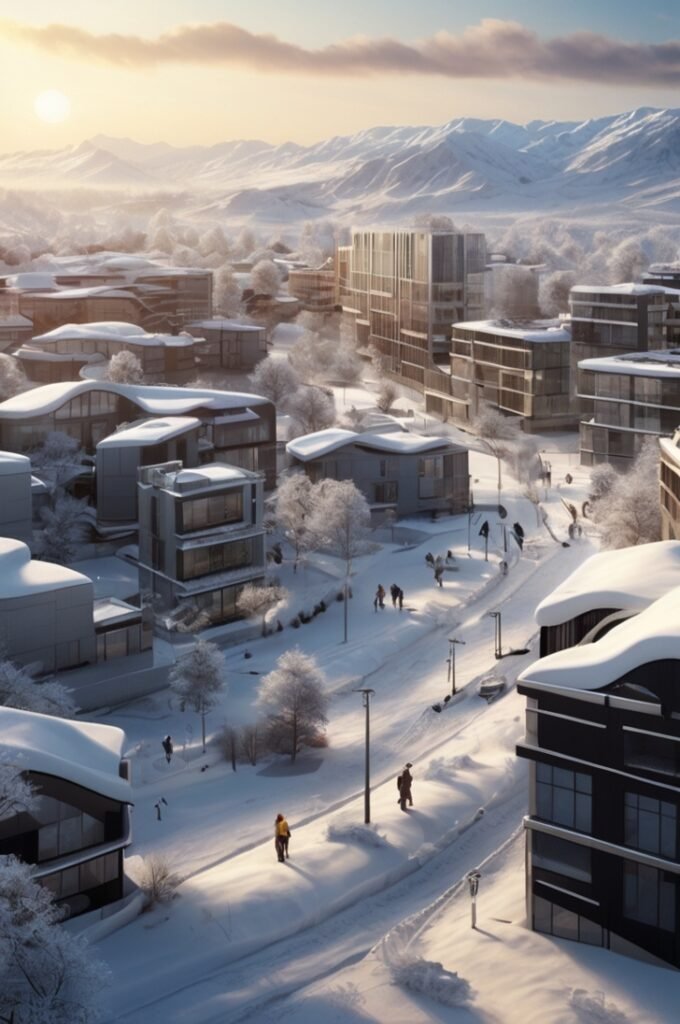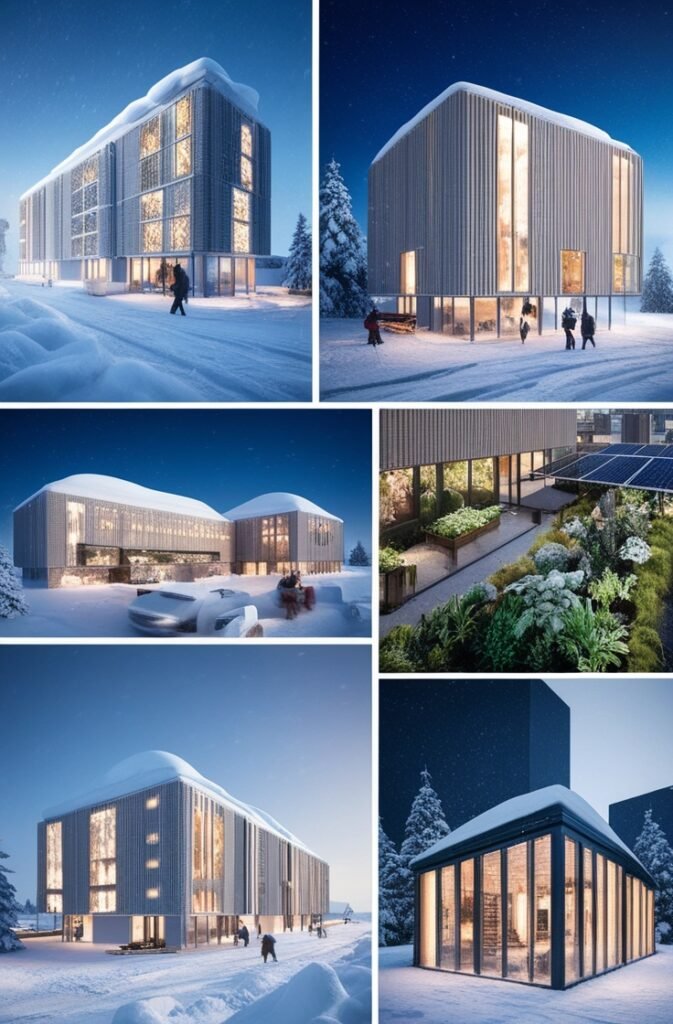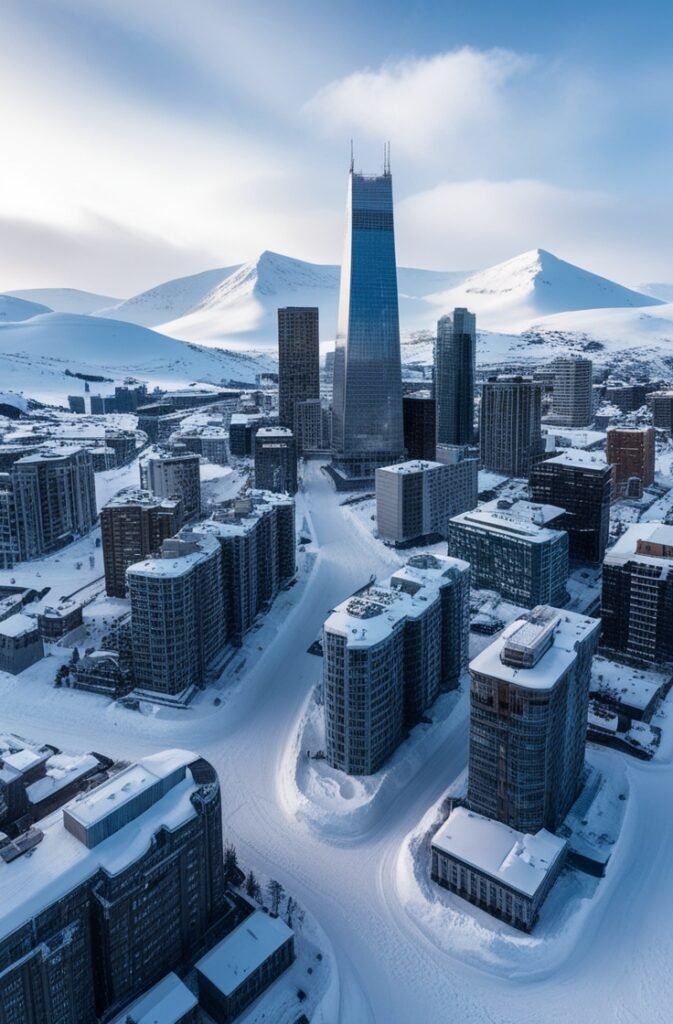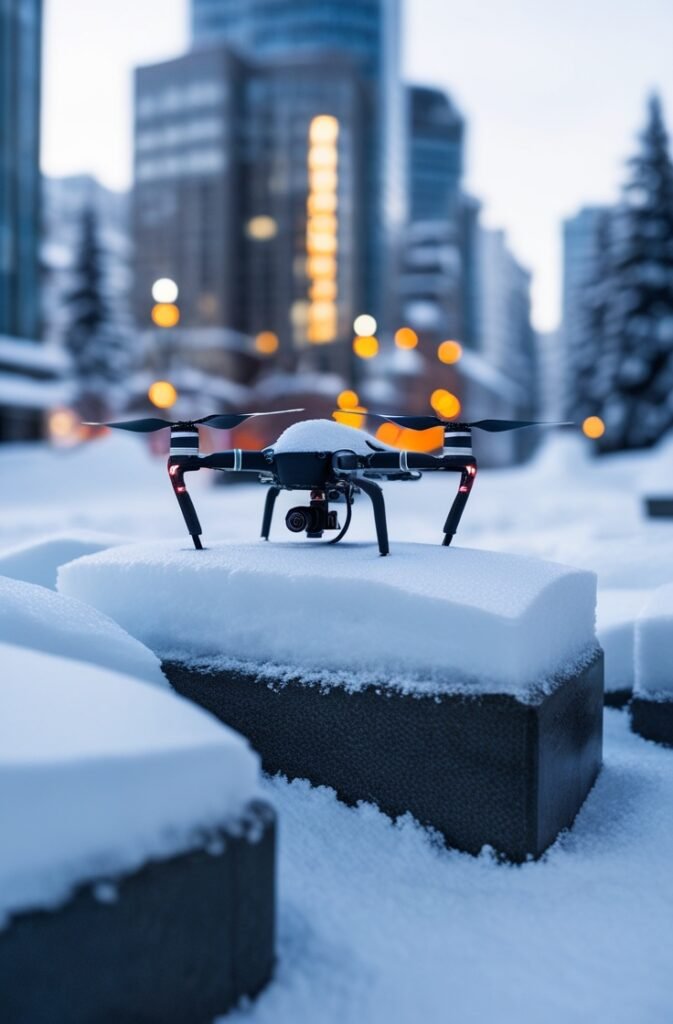
Introduction to the Futuristic City
Imagine a city where the landscape is adorned with glistening snow, a striking fusion of nature and cutting-edge technology. This futuristic snow-capped city embodies a unique allure, promising a captivating blend of aesthetic beauty and modern conveniences. Unlike traditional urban environments, this innovative model prioritizes sustainability, advanced infrastructure, and environmental harmony.
The concept of a snow-capped city is not just about snow-covered rooftops and frosty parks; it involves a meticulous design that integrates green technologies and smart systems. With towering structures designed to withstand heavy snowfall, these buildings utilize advanced materials that provide insulation and energy efficiency, allowing inhabitants to thrive in a winter wonderland. Moreover, the city’s layout will promote walkability and reduce reliance on fossil fuels, aligning with modern trends in sustainable urban development.








Beyond its technological achievements, the enchanting beauty of a snow-filled landscape offers substantial psychological advantages. Studies have suggested that environments blanketed in snow can enhance overall well-being and promote a sense of tranquility. Consequently, the residents of this futuristic city may enjoy improved mental health, higher levels of satisfaction, and a deeper connection with the serene natural scenery that surrounds them.
As climate change influences urban planning, this city stands out as a forward-thinking response that capitalizes on frigid temperatures and snowy conditions. By harnessing renewable energy sources such as wind and solar power, the city is not only eco-friendly but also resilient to the challenges of climate change. It emerges as a model for future development, where prosperity and sustainability coexist, and advanced technology enhances everyday living experiences amidst a picturesque wintry backdrop.








Architectural Innovations
The skyline of a futuristic snow-capped city is marked by an array of architectural innovations that seamlessly blend form, function, and sustainability. A key aspect of these designs is the use of sustainable materials, which not only minimize the ecological footprint but also enhance the longevity and performance of the structures. For instance, advanced composites and recyclable materials are becoming increasingly prevalent, providing a robust framework that can endure severe weather conditions while maintaining an elegant appearance.
Energy-efficient structures play a pivotal role in the architectural landscape of this envisioned city. Buildings are designed with advanced insulation technologies and energy systems that significantly reduce heating demands during the harsh winter months. Solar panels and wind turbines are integrated into the architecture, not merely as add-ons but as integral components, effectively transforming rooftops into energy-generating surfaces. Such innovations facilitate a renewable energy cycle, allowing the city to thrive in harmony with its breathtaking snow-covered surroundings.




Moreover, smart designs are vital in determining the resilience and adaptability of the city’s architecture. These designs include features such as snow-melting systems embedded within walkways and rooftops, preventing excessive accumulation and minimizing hazards. Buildings are equipped with adaptive facades that respond to environmental changes, optimizing internal temperatures and light levels throughout the year. Beyond mere functionality, these innovations contribute to an aesthetic that complements and enhances the inherent beauty of the snowy landscape.
By harmonizing architectural innovation with nature, this snow-capped city exemplifies a forward-thinking approach to urban development. Commitments to sustainability and functionality ensure these futuristic designs are not just visions of tomorrow, but practical solutions that can be implemented today. Through the careful integration of sustainable practices and smart technologies, the architectural landscape becomes a testament to what is achievable in balance with the environment.




Transportation in a Snowy Wonderland
In a snow-capped futuristic city, transportation stands as a testament to innovation and practicality, designed to seamlessly integrate with the icy landscape while ensuring safety and efficiency. Central to this evolution are advanced public transport systems that prioritize both reliability and sustainability. High-speed electric tram networks, engineered to perform flawlessly in snowy conditions, offer commuters fast and eco-friendly options for travel. These trams are equipped with sensors and heated tracks that prevent snow accumulation, ensuring smooth operation even in severe winter weather.
Alongside public transit, autonomous vehicles are revolutionizing personal mobility in this snowy environment. These vehicles utilize state-of-the-art technologies, including LiDAR and advanced AI, to navigate the often challenging icy terrain. Equipped with enhanced traction control and snow-specific driving modes, these self-driving cars can safely transport passengers regardless of the frigid conditions. Moreover, the incorporation of connected vehicle systems allows for real-time updates on weather and road conditions, enabling drivers and passengers alike to make informed decisions about their routes.




Pedestrian-friendly designs also play a critical role in transforming the transportation landscape of this snowy wonderland. Cities are being reimagined with spacious walkways that are regularly cleared of snow and ice, ensuring safe and accessible travel for pedestrians. Smart street lighting and heated sidewalks are being implemented to enhance visibility and comfort during winter nights. Additionally, integrated bike lanes equipped with snow-clearing technology promote cycling, making it a viable option even in inclement weather.
As transportation systems evolve, they not only address the unique challenges posed by snow and ice but also actively contribute to a sustainable urban ecosystem where safety and accessibility are paramount. This future-forward approach ensures that the snowy wonderland remains a place where mobility thrives, regardless of the seasonal challenges.




Climate Control and Sustainability
In the vision of a futuristic snow-capped city, the integration of advanced technologies for climate control and sustainability is paramount. The architectural designs of buildings are meticulously crafted to handle the challenges posed by harsh winter conditions, particularly snow and low temperatures. The structures are equipped with innovative materials that provide excellent thermal insulation, thereby minimizing heat loss and ensuring indoor comfort. Such technologies allow for reduced energy consumption, contributing to the overall sustainability of the city.
To further enhance energy efficiency, the buildings incorporate rooftop gardens and green spaces, which not only help with insulation but also contribute to urban biodiversity. These elements serve as natural insulators, reducing the need for excessive heating during the winter months. The innovative use of solar panels is also prevalent, harnessing renewable energy to power the city while mitigating the carbon footprint associated with conventional heating methods.




Moreover, the incorporation of smart grids plays a crucial role in managing energy distribution effectively. By utilizing real-time data and analytics, the city can optimize energy usage in response to climatic conditions and demand fluctuations. This approach enables a balance between sustainable living and the needs of urban dwellers, ensuring that resources are used wisely and efficiently.
In addition to energy innovations, snow management techniques are also essential in maintaining urban mobility and safety. The city’s design includes underground heating systems that prevent snow accumulation on walkways and streets, allowing for safe transit. Furthermore, the use of permeable materials in pavements promotes efficient melting of snow while facilitating rainwater absorption, reducing flooding risks and promoting responsible water management.




Overall, the commitment to climate control and sustainability within this snow-capped city exemplifies a harmonious coexistence between advanced technology and nature, paving the way for resilient urban living amidst changing environmental conditions.




Cultural and Recreational Spaces
The futuristic snow-capped city is characterized by its innovative cultural and recreational spaces that cater to both residents and visitors, encouraging community engagement and fostering a sense of belonging. Parks and open spaces are meticulously designed to blend harmoniously with the snowy landscape while providing essential areas for relaxation and recreation. These green spaces, adorned with seasonal flora, offer tranquil environments that invite individuals and families to explore nature, partake in winter sports, or simply unwind amidst the picturesque scenery.
Community centers play a pivotal role in this city, providing venues for various cultural activities. These centers are equipped with multi-purpose rooms that can host art exhibitions, workshops, and festivals that celebrate the unique heritage and diversity of the area. Furthermore, they serve as hubs for local gatherings, where events such as winter markets and holiday fairs are held, fostering a vibrant community spirit. In these community spaces, residents can engage with their neighbors, learn from local artisans, and share their own cultural expressions.




Winter sports facilities are another key element that enhances the recreational offerings of the city. These specialized areas are constructed with advanced technology to ensure optimal conditions for activities such as skiing, ice skating, and snowboarding. The presence of artificial hills and ice rinks allows for year-round enjoyment, further encouraging health and wellness among residents. With organized sporting events and competitions, these facilities not only promote active lifestyles but also serve as platforms for community interaction and pride.
Overall, the integration of these cultural and recreational spaces within the snowy environment plays a significant role in promoting sustainable living while enriching the lives of the city’s inhabitants. The seamless connection between leisure, culture, and nature embodies the essence of a futuristic snow-capped city, making it a desirable place to live, work, and visit.




Smart Technology Integration
The introduction of smart technology within a snow-capped city significantly enhances urban living and resource management. By employing Internet of Things (IoT) devices, urban planners and city officials can harness data, streamline operations, and improve the everyday experiences of residents and visitors alike. This integration begins with smart infrastructure, where sensors are embedded in roads, buildings, and public spaces to monitor essential factors such as temperature, occupancy, and snow levels. For instance, IoT sensors placed on sidewalks can detect the accumulation of snow and ice, triggering automated snow removal systems to ensure safe passage for pedestrians.
Public safety is enhanced through smart surveillance technologies, which utilize AI-powered cameras to monitor urban areas in real-time. These systems can detect unusual activities or situations, such as accidents through advanced analytics, allowing for rapid emergency responses. Moreover, smart lighting systems adjust based on the time of day and weather conditions, ensuring well-lit streets while conserving energy during low-traffic periods. This dual-benefit approach contributes to both safety and energy efficiency.




Furthermore, the integration of smart traffic management systems can ease congestion commonly experienced in snow-capped areas. Utilizing live data from connected vehicles and sensors, these systems can optimize signal timings, thus allowing for smoother traffic flow even during inclement weather. Additionally, residents can benefit from smart apps providing real-time updates on public transport schedules, road conditions, and weather forecasts, ensuring that they are well-informed and prepared for their commutes.
Overall, smart technology integration not only boosts operational efficiency but substantially enhances the quality of life within the city, allowing its inhabitants to navigate the challenges of a snow-covered environment effectively.




Life in a Snow-Capped City
Living in a futuristic snow-capped city presents a unique and enriching experience for its residents. The inhabitants adapt their lifestyle to harmonize with the challenges posed by a consistently snowy environment while also celebrating the joys it brings. Daily life in such a city revolves around a deep appreciation for winter activities, communal gatherings, and innovative adaptations to the cold climate.
One of the most notable aspects of life in this frosty urban landscape is the strong sense of community. Residents often come together to organize seasonal events, such as winter festivals and ice sculpting competitions, fostering a spirit of camaraderie. These gatherings not only celebrate the beauty of snow but also provide opportunities for residents to bond, enhance social ties, and create memorable experiences together. A vibrant social calendar allows individuals and families to engage with one another, promoting a supportive atmosphere that is essential in a snowy environment.




Furthermore, technological advancements significantly enable residents to manage the demands of daily life amidst frequent snowfall. Innovative infrastructure, such as heated walkways and smart snow management systems, ensures safety and accessibility throughout the city, minimizing disruptions caused by winter storms. This technology also allows residents to engage in outdoor activities, from skiing to snowboarding, which further enriches community life.
While challenges such as extreme cold and snow-related maintenance activities are inherent to residing in a snow-capped city, the overall lifestyle is one of resilience and celebration. Residents embrace seasonal challenges with optimism, taking pride in their ability to adapt and thrive in their unique environment. This blend of enjoyment and perseverance illustrates that life in a snowy urban setting can be both fulfilling and vibrant.




Challenges and Solutions
Living in a futuristic, snow-capped city presents unique challenges that stem primarily from extreme weather conditions and resource management. The persistent snowfall and low temperatures can create hurdles such as transportation issues, energy consumption, and infrastructure maintenance. Roads may become impassable, while the accumulation of snow on buildings and public areas creates safety hazards. Additionally, the high energy demands for heating and snow clearance can strain city resources and impact sustainability initiatives.
However, addressing these challenges necessitates innovative solutions that leverage advanced technologies and efficient practices. One prominent solution lies in the development of smart transportation systems. These systems utilize real-time data, enabling adaptive traffic management that accommodates variable weather conditions. Equipped with sensors, smart vehicles can detect icy patches and adjust their operation accordingly, improving safety for residents navigating the snowy landscape.




Moreover, implementing sustainable energy solutions is essential in snowy environments. Integrating renewable energy sources, such as solar panels or wind turbines, can help reduce dependency on fossil fuels. These systems can be designed to withstand harsh weather conditions and continue generating energy even during heavy snowfall. Additionally, cities can explore innovative snow management technologies, such as snow melting systems that utilize heated pavement or underground heating to minimize accumulation on roadways.
Resource management can also be enhanced through the adoption of circular economy principles. By persisting on recycling and reusing snow, cities can mitigate its impact on infrastructure and promote environmental sustainability. For example, snow can be collected and utilized for irrigation in warmer seasons, ensuring that water resources are optimized throughout different climatic phases.




Ultimately, transitioning to a snow-capped city that thrives despite its unique challenges requires a proactive approach that embraces technological innovation and sustainability practices. This not only improves overall quality of life but also establishes a resilient infrastructure capable of adapting to the rigors of a winter landscape.




Future Prospects and Developments
The evolution of snow-capped cities is increasingly intertwined with advancements in technology and urban planning practices. As climate change continues to present challenges, the integration of sustainable solutions is becoming paramount. Innovative approaches in urban design are anticipated to reshape snow-capped environments, enhancing resilience while providing livable spaces. For instance, smart city technologies are set to play a pivotal role in resource management and energy efficiency, ensuring that these urban centers thrive despite harsh winter conditions.
One significant trend is the development of climate-adaptive infrastructure. Developers are exploring materials and building techniques that can withstand extreme cold while reducing heating costs and energy consumption. These advancements may include the use of advanced insulation materials, energy-efficient windows, and innovative heating systems powered by renewables. Enhanced thermal performance will thus become essential for maintaining comfort in winter landscapes.








Moreover, smart technology will likely streamline public services in snow-capped cities. This could involve the implementation of intelligent snow management systems that utilize real-time data to optimize snow removal. Drones and automated vehicles are expected to become common features, improving logistics and ensuring safer mobility through improved snow and ice clearance strategies. Equally, smart lighting systems equipped with sensors may enhance safety and accessibility during long winter nights.
As urban populations continue to rise, the demand for sustainable, multifunctional spaces in snow-capped cities will grow. Multi-use buildings that combine residential, commercial, and recreational spaces can support vibrant communities while minimizing urban sprawl. The future may also see the incorporation of green spaces and urban forests, which not only contribute to biodiversity but also provide residents with nature-based experiences amidst the snow-covered urban backdrop.




Ultimately, the ongoing interaction between technological innovation and urban planning will define the future of snow-capped cities. As these developments unfold, residents can anticipate a transformation that embraces both the beauty of winter and the necessities of modern urban living.




RELATED POSTS
View all


